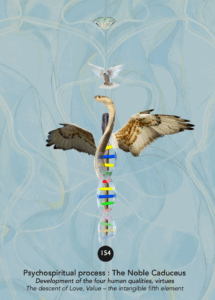An Ontological Perspective on Spirituality, Well-being, and Health
The evolution of human consciousness is often framed through religion or through science—as if the two were opposed. But this is a false dichotomy. Each can speak to the deeper questions of being, particularly when we consider models that are ontological in scope: asking what it means to exist, to evolve, and to heal.
This paper offers a layered reading of the human being—spiritual, psychological, biological, and symbolic—using the structure of the caduceus (staff, snake, wings, dove) alongside a model of human development rooted in epigenesis and emanationism. It invites a reconsideration of what health is: not simply physiological balance, but a deeper alignment of multiple selves, each with their own station and significance.
From Staff to Caduceus: The Symbol as a Map of Being
The traditional symbol for healing in Greek mythology is the Rod of Asclepius—a single serpent coiled around a staff. Over time, however, the modern medical emblem came to resemble the Caduceus: a double-serpent staff often winged, associated with Hermes/Mercury, the messenger god.
Many have commented on the confusion between these symbols. But from an ontological point of view, this shift signals something useful: an evolution from a purely physical understanding of healing (the body) to a more complex symbolic system involving movement, polarity, ascent, and transcendence.
The Caduceus and 5 Hearts—when read archetypally—can be broken into five components:


- Staff — Integrity: structure, central axis, unifying vertical thread. This represents the implicate order: the inherent integrity of being, our capacity to align with what is.
- Snake(s) — Flexibility: movement, adaptation, life force, transformation. These spiral movements mirror DNA, the autonomic system, and the undulations of consciousness through complexity.
- Wings — Reflectiveness: perspective, light, nous (intellect). This is the capacity to view life not only through instinct or reaction, but from a place of spacious awareness.
- Dove — Submission: surrender to something greater. The dove represents divine descent: the action of Grace, Ruḥ (Spirit), or Presence entering the human field.
- Heart(s) — Valuation: the location and source of meaning, where Love descends. Each ‘heart’ represents a domain of consciousness or intelligence through which being is known and offered:
- Physical Heart (matter, biology, vitality)
- Emotional Heart (feeling, empathy, resonance)
- Instinctual Heart (movement, defence, sexuality)
- Cognitive Heart (discernment, intellect, nous)
- Spiritual Heart (submission, unity, knowledge through Grace)
The five hearts correspond to the ascending levels of the self and also to specific qualities of health. Together, they help explain why healing cannot be isolated to tissue or organ. True well-being reflects a harmony across all five stations.
Emanationism: Descent and Return
Across spiritual traditions—Jewish Kabbalah, Islamic cosmology, Eastern Christianity, and Neoplatonism—we find a shared idea: that the Divine Essence emanates through levels, pouring into matter. This pouring is not a fall from grace, but a journey: from Oneness through duality to multiplicity. The human being is both product and witness of this journey.
Emanation means God (or First Cause) chooses to be known. Spirit descends, becomes clothed in matter, and seeks its return.
We may describe this journey through seven levels of being:
- Material – the body as substance
- Vegetal – physiological life and cellular intelligence
- Animal – instinct, desire, territoriality, movement
- Human – abstraction, language, ethics, self-reflection
- Noble – the epigenetic potential for inner transformation
- Saint – a life conformed to divine reality
- Prophetic – embodiment of divine mission
These stages are not only metaphors. They are observed in physiology (developmental stages), in embryology (layered growth), and clinical observations. Each layer unfolds as part of a teleological design: nature, through the human, reaches toward something more.
The Interior Castle: Mansions of the Self
![]()
St. Teresa of Avila’s Interior Castle describes seven mansions: the inner stations the soul must traverse in its journey to union with God. These can be mapped to the seven levels above.
In a more physiological register, these ‘rooms’ can also be described as niches within the human system where different ‘selves’ reside: instinctual, emotional, cognitive, etc. In healing work, the disorder of these niches—when one dominates inappropriately—leads to imbalance, illness, and fragmentation.
We can imagine the human body as a castle, with staircases formed by the caduceus and its fivefold symbolic system. A disordered self may find its snake strangling the dove, its wings clipped by rigidity, or its staff fractured. Healing restores proper relationship. Love is the medicine that overcomes all ills. The development of these psychospiritual virtues are parmanount in our quest of becoming.
Summary
- The caduceus is more than a medical symbol; it is a mythic map of selfhood and healing.
- Its components represent five essential qualities: integrity, flexibility, reflectiveness, submission, and value.
- These correlate with five hearts or domains of being.
- Through the process of emanation, Spirit descends into matter, becoming clothed in successive layers. Healing is a return journey.
- The interior castle reveals our inner architecture. Each ‘mansion’ must be visited, inhabited, and reordered.
- Clinical observations show that disorders of the symbolic system are often at the root of persistent illness. Healing requires symbolic as well as physiological restoration.
This ontological model provides a way to integrate spirituality, psychology, and medicine. It does not replace biology—it deepens it. And it suggests that the work of the healer is not simply to fix what is broken, but to help realign the soul, so the person can continue the sacred journey from matter to meaning, from multiplicity to unity, from health to wholeness.